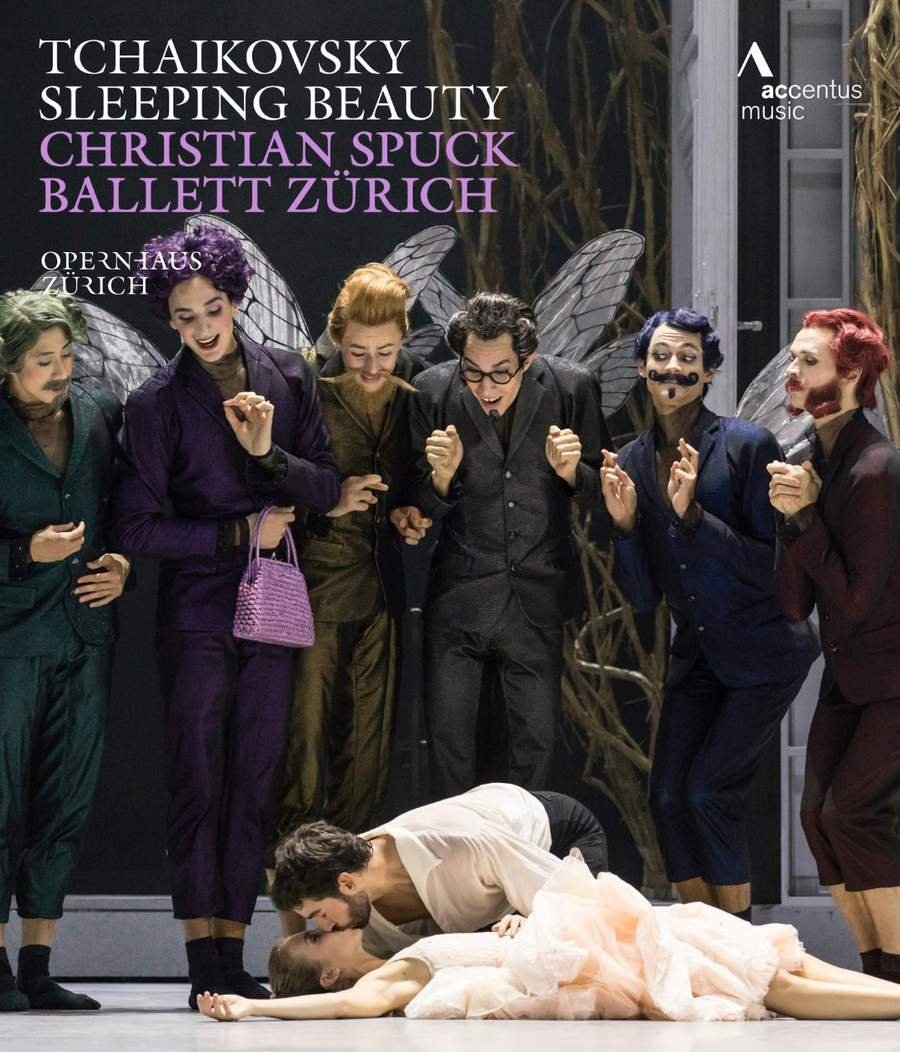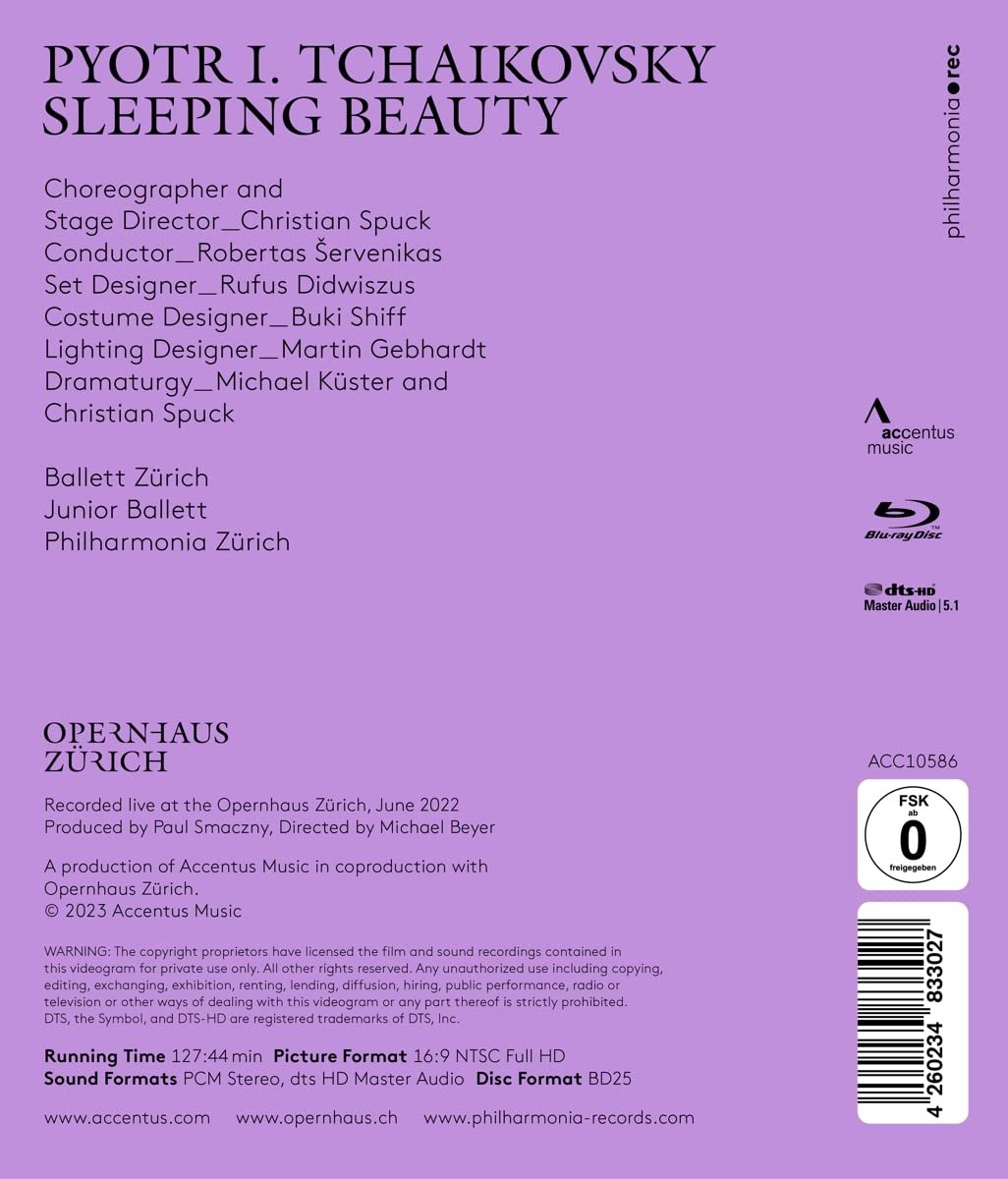

Sleeping Beauty ballet. Music by Tchaikovsky. Directed and choreographed in 2022 by Christian Spuck at Opernhaus Zürich. Stars Michelle Willems (Aurora), Esteban Berlanga (Prince Désiré), Lucas Valente (King), Inna Bilash (Queen), William Moore (Carabosse), Jan Casier (Lilac Fairy), Cohen Aitchison-Dugas, Matthew Bates, Dominik White Slavkovshý, Wei Chen, and Mark Geilings (Faries) as well as many other dancers from Ballett Zürich and the Junior Ballett. Robertos Šervenikas conducts the Philharmonia Zürich. Set design by Rufus Didwiszus; costume design by Buki Shiff; lighting design by Martin Gebhardt; dramaturgy by Michael Küster and Christian Spuck. Directed for TV by Michael Beyer; produced by Paul Smaczny. Released 2023, disc has 5.1 dts-HD Master Audio sound. Grade: A- with the ‽ designation.
Spuck has been an important choreographer, primarily in Stuttgart and Zürich, since 1996. We have reviewed 5 ballet HDVDs from Spuck on this website mostly from his productions for Ballet Zürich. His Sleeping Beauty premiered in 2020, but closed during the Covid-19 pandemic. The show on this disc was recorded in June 2022. Spuck recently became artistic director of the Staatsballett Berlin for the 2023/24 season, where he will serve the Deutsche Oper Berlin, the Komische Oper Berlin, and the Staatsoper Unter den Linden.
Spuck likes to inject classical ballet and music titles with jarring psychological twists. A bizarre twist here is his creation of 3 mother/father time characters who are always available as the set turns. They have long hair and skirts like women but have beards. They do little other than sit, appear weird, and sometimes slowly look at their oversize watches:
Equally androgynous are the 7 fairies, all danced by men. Next below are the 5 minor fairies, coached to be as outrageously effeminate as possible. From left to right they are Wei Chen, Dominik White Slavkovshý, Matthew Bates, Cohen Aitchison-Dugas, and Mark Geilings:
The Lilac Fairy is not so effeminate. After debate, I decided that Lilac was danced by a woman. But no, research revealed that Jan Casier is a man:
The most aggressive Fairy is, of course, Carabosse, here played by William Moore. You know she’s female because she has those little wings:
Well, let’s see—this is a story about a virgin princess named Aurora. Here she is danced by the French and Bolshoi-trained Michelle Willems:
Michelle is a lovely woman and beautiful dancer. But she was picked for this part because she looks like she might have a brain and she can also act. Spuck needed this combination because his Aurora was not just a typical virgin princess—she was a stolen baby growing up under profound non-diagnosed stress:
Where did Spuck come up with the stolen baby angle? Well, there really are stolen babies. Sometimes a baby is stolen just for money from a hapless unwed mom who is told that her baby died at birth. During the “dirty wars” in Chili and Argentina subversive women were arrested. Those who were pregnant were allowed to live until the baby was born. The mother was then murdered. The baby was harvested for a “good” family to adopt or for sale.
Stolen babies often wind up with innocent parents who think they are adopting a child in need. Adopted children sometimes come to have doubts. There are charities that are successful right now helping stolen children find their birth moms. These stories maybe inspired Spuck.
According to Spuck, in the days of old, fairies brought babies to the humans. The King and Queen had given up trying to have a child on their own. So they stole the baby at the time under the care of Carabosse, the leader of the faires. This wasn’t an innocent act—it was outright theft. Next below is the King (Lucas Valente) and the Queen (Inna Bilash):
And since we are at court, there are many opportunities for beautiful dances:
And when the new baby is presented, the fairies climb up the walls on convenient little ladders built into the set:
Now in the real world, lechers like me pay for most of the ballet tickets. So every ballet should have some kind of sex symbol for us. This Spuck provides via the Carabosse bodyguard of lascivious female rodents with frizzy bleached-blond hair. Next below Carabosse puts her curse on Aurora. Carabosse really meant the curse to be on the King and Queen. But Carabosse got confused and the curse fell on the baby. Carabosse is filled with remorse that she can never live down:
Aurora isn’t all that close to the King and Queen. From time to time she encounters Carabosse, with whom she seems to have a special, mysterious connection:
Now Aurora is coming of age. Spuck gives us a perverse, disastrous, cringe-inducing anti-rose-adagio scene:
Mother/father time gives Aurora the spindle, and the Lilac Fairy puts everyone to sleep:
100 years pass. In Act 2 we find the palace overgrown with thorns and defaced:
The melancholy Prince Désiré (Esteban Berlanga) arrives at the ruin with a princess assigned to entertain him. Something tells him to stay at the ruin alone while the others continue the hunt:
Having spelled out for you what Spuck does in his radical Prologue and Act 1, I trust you will follow Act 2 without too much trouble. It’s short and leads to the end you expect after more odd twists from Spuck. (I will tell you now there are no other fairy tale characters like the Bluebirds at the end).
This is Spuck’s most challenging work to come out in Blu-ray. If you were to see this cold, you would likely get confused just as I did. It’s less about finding love and more about finding truth. The choreography, dancing prowess, directing, acting, sets, and costumes are outstanding. The orchestra played well and the recording is fine. The music is maybe the best ballet score ever written. Here the music here was substantially rearranged, which made me feel I was hearing it for the first time. The box comes with a lavish booklet, in which Spuck explains some of his thinking. But neither the booklet nor the box art tells us who the stars are—I had to figure this out on my own.
In the past, I’ve often criticized Michael Beyer for shooting his video with too many short video clips. The fast pace can interfere with one’s enjoyment of the long dancing line. But I decided not to complain about Beyer’s pace in this shoot. Here the video tracks well the multitude of radical ideas that Spuck presents in his story telling.
I grade this A+ grade for the experienced ballet lover looking for something different. But caution about showing this to a traditional ballet fan or newbie. So I give this the ‽ designation, and I wind up with an A- grade overall.
At the time I write this, I’m guessing that Spuck is tearing things apart all over Berlin and planning incredible new works in the world’s most avant-garde city. Good luck Spuck! (I know, the German “spuck” doesn’t rhyme with the English “luck.”)


















